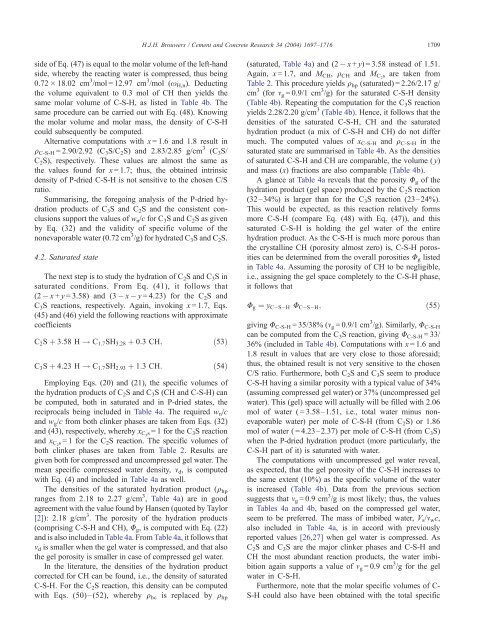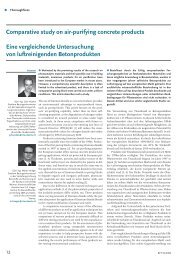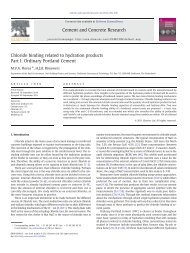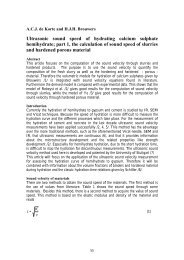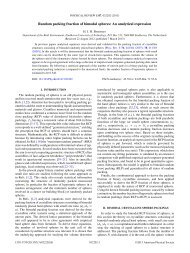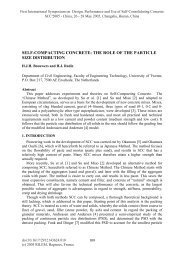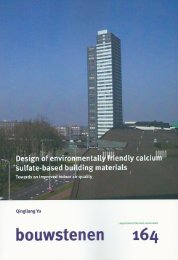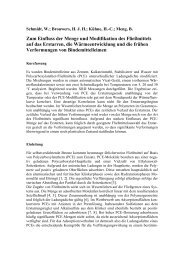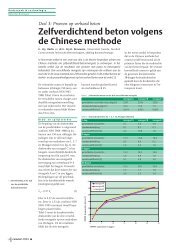The work of Powers and Brownyard revisited: Part 1 - Jos Brouwers
The work of Powers and Brownyard revisited: Part 1 - Jos Brouwers
The work of Powers and Brownyard revisited: Part 1 - Jos Brouwers
Create successful ePaper yourself
Turn your PDF publications into a flip-book with our unique Google optimized e-Paper software.
H.J.H. <strong>Brouwers</strong> / Cement <strong>and</strong> Concrete Research 34 (2004) 1697–1716 1709(saturated, Table 4a) <strong>and</strong> (2 x + y) = 3.58 instead <strong>of</strong> 1.51.side <strong>of</strong> Eq. (47) is equal to the molar volume <strong>of</strong> the left-h<strong>and</strong>with Eqs. (50)–(52), whereby q hc is replaced by q hp S-H could also have been obtained with the total specificside, whereby the reacting water is compressed, thus being0.72 18.02 cm 3 /mol = 12.97 cm 3 /mol (x H,n ). Deductingthe volume equivalent to 0.3 mol <strong>of</strong> CH then yields thesame molar volume <strong>of</strong> C-S-H, as listed in Table 4b. <strong>The</strong>same procedure can be carried out with Eq. (48). Knowingthe molar volume <strong>and</strong> molar mass, the density <strong>of</strong> C-S-Hcould subsequently be computed.Alternative computations with x = 1.6 <strong>and</strong> 1.8 result inq C-S-H = 2.90/2.92 (C 3 S/C 2 S) <strong>and</strong> 2.83/2.85 g/cm 3 (C 3 S/C 2 S), respectively. <strong>The</strong>se values are almost the same asthe values found for x = 1.7; thus, the obtained intrinsicdensity <strong>of</strong> P-dried C-S-H is not sensitive to the chosen C/Sratio.Summarising, the foregoing analysis <strong>of</strong> the P-dried hydrationproducts <strong>of</strong> C 3 S <strong>and</strong> C 2 S <strong>and</strong> the consistent conclusionssupport the values <strong>of</strong> w n /c for C 3 S <strong>and</strong> C 2 S as givenby Eq. (32) <strong>and</strong> the validity <strong>of</strong> specific volume <strong>of</strong> thenonevaporable water (0.72 cm 3 /g) for hydrated C 3 S <strong>and</strong> C 2 S.Again, x = 1.7, <strong>and</strong> M CH , q CH <strong>and</strong> M C2 s are taken fromTable 2. This procedure yields q hp (saturated) = 2.26/2.17 g/cm 3 (for m g = 0.9/1 cm 3 /g) for the saturated C-S-H density(Table 4b). Repeating the computation for the C 3 S reactionyields 2.28/2.20 g/cm 3 (Table 4b). Hence, it follows that thedensities <strong>of</strong> the saturated C-S-H, CH <strong>and</strong> the saturatedhydration product (a mix <strong>of</strong> C-S-H <strong>and</strong> CH) do not differmuch. <strong>The</strong> computed values <strong>of</strong> x C-S-H <strong>and</strong> q C-S-H in thesaturated state are summarised in Table 4b. As the densities<strong>of</strong> saturated C-S-H <strong>and</strong> CH are comparable, the volume ( y)<strong>and</strong> mass (x) fractions are also comparable (Table 4b).A glance at Table 4a reveals that the porosity U g <strong>of</strong> thehydration product (gel space) produced by the C 2 S reaction(32–34%) is larger than for the C 3 S reaction (23–24%).This would be expected, as this reaction relatively formsmore C-S-H (compare Eq. (48) with Eq. (47)), <strong>and</strong> thissaturated C-S-H is holding the gel water <strong>of</strong> the entirehydration product. As the C-S-H is much more porous thanthe crystalline CH (porosity almost zero) is, C-S-H porosities4.2. Saturated statecan be determined from the overall porosities U g listedin Table 4a. Assuming the porosity <strong>of</strong> CH to be negligible,<strong>The</strong> next step is to study the hydration <strong>of</strong> C 2 S <strong>and</strong> C 3 Sinsaturated conditions. From Eq. (41), it follows thati.e., assigning the gel space completely to the C-S-H phase,it follows that(2 x + y = 3.58) <strong>and</strong> (3 x y = 4.23) for the C 2 S <strong>and</strong>C 3 S reactions, respectively. Again, invoking x = 1.7, Eqs. U g ¼ y C S H U C S H ; ð55Þ(45) <strong>and</strong> (46) yield the following reactions with approximatecoefficientsC 2 S þ 3:58 H ! C 1:7 SH 3:28 þ 0:3 CH;ð53Þgiving U C-S-H = 35/38% (m g = 0.9/1 cm 3 /g). Similarly, U C-S-Hcan be computed from the C 3 S reaction, giving U C-S-H = 33/36% (included in Table 4b). Computations with x = 1.6 <strong>and</strong>1.8 result in values that are very close to those aforesaid;C 3 S þ 4:23 H ! C 1:7 SH 2:93 þ 1:3 CH:ð54Þ thus, the obtained result is not very sensitive to the chosenC/S ratio. Furthermore, both C 2 S <strong>and</strong> C 3 S seem to produceEmploying Eqs. (20) <strong>and</strong> (21), the specific volumes <strong>of</strong>the hydration products <strong>of</strong> C 2 S <strong>and</strong> C 3 S (CH <strong>and</strong> C-S-H) canbe computed, both in saturated <strong>and</strong> in P-dried states, thereciprocals being included in Table 4a. <strong>The</strong> required w n /c<strong>and</strong> w g /c from both clinker phases are taken from Eqs. (32)<strong>and</strong> (43), respectively, whereby x C3 s = 1 for the C 3 S reaction<strong>and</strong> x C2 s = 1 for the C 2 S reaction. <strong>The</strong> specific volumes <strong>of</strong>both clinker phases are taken from Table 2. Results aregiven both for compressed <strong>and</strong> uncompressed gel water. <strong>The</strong>mean specific compressed water density, m d , is computedwith Eq. (4) <strong>and</strong> included in Table 4a as well.<strong>The</strong> densities <strong>of</strong> the saturated hydration product (q hpranges from 2.18 to 2.27 g/cm 3 , Table 4a) areingoodagreement with the value found by Hansen (quoted by Taylor[2]): 2.18 g/cm 3 . <strong>The</strong> porosity <strong>of</strong> the hydration products(comprising C-S-H <strong>and</strong> CH), U g , is computed with Eq. (22)<strong>and</strong> is also included in Table 4a. From Table 4a, it follows thatm d is smaller when the gel water is compressed, <strong>and</strong> that alsothe gel porosity is smaller in case <strong>of</strong> compressed gel water.In the literature, the densities <strong>of</strong> the hydration productcorrected for CH can be found, i.e., the density <strong>of</strong> saturatedC-S-H. For the C 2 S reaction, this density can be computedC-S-H having a similar porosity with a typical value <strong>of</strong> 34%(assuming compressed gel water) or 37% (uncompressed gelwater). This (gel) space will actually will be filled with 2.06mol <strong>of</strong> water ( = 3.58–1.51, i.e., total water minus nonevaporablewater) per mole <strong>of</strong> C-S-H (from C 2 S) or 1.86mol <strong>of</strong> water ( = 4.23–2.37) per mole <strong>of</strong> C-S-H (from C 3 S)when the P-dried hydration product (more particularly, theC-S-H part <strong>of</strong> it) is saturated with water.<strong>The</strong> computations with uncompressed gel water reveal,as expected, that the gel porosity <strong>of</strong> the C-S-H increases tothe same extent (10%) as the specific volume <strong>of</strong> the wateris increased (Table 4b). Data from the previous sectionsuggests that m g = 0.9 cm 3 /g is most likely; thus, the valuesin Tables 4a <strong>and</strong> 4b, based on the compressed gel water,seem to be preferred. <strong>The</strong> mass <strong>of</strong> imbibed water, V s /m w c,also included in Table 4a, is in accord with previouslyreported values [26,27] when gel water is compressed. AsC 2 S <strong>and</strong> C 3 S are the major clinker phases <strong>and</strong> C-S-H <strong>and</strong>CH the most abundant reaction products, the water imbibitionagain supports a value <strong>of</strong> m g = 0.9 cm 3 /g for the gelwater in C-S-H.Furthermore, note that the molar specific volumes <strong>of</strong> C-


